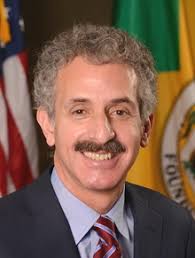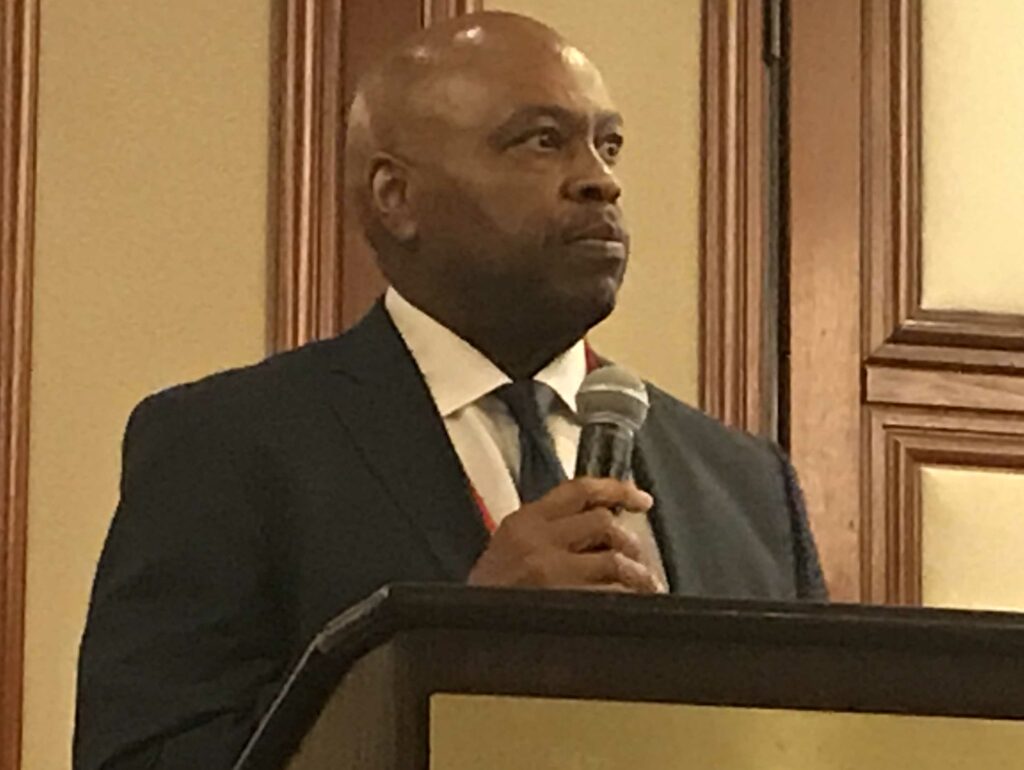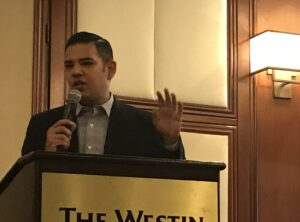The local legacy media all but overlooked a crucial note in reports of the latest raid of LA City Hall by federal agents, who most recently hit the joint on July 22, when they added the City Attorney’s office and the headquarters of the Department of Water and Power as targets of their widening probe.
Reports indicate that warrants for the various searches included a green light for investigators to seek evidence of money laundering.

That makes all the more reason to wonder why Mayor Eric Garcetti and the Los Angeles City Council signed off on 14th District Councilmember Jose Huizar’s proposal for the development of a homeless shelter that includes inexplicably favorable lease terms for a landlord with a record of involvement in money laundering.
The lease is for space at a warehouse at 1426 S. Paloma Street, on the industrial edge of Downtown.
The deal calls for payments of $1.2 million over three years to the landlord, who is identified as Moiz Kaboud.
The same Kaboud paid $500,000 to settle a prior case of money laundering, according to federal, state and city documents.
The May 14 edition of SullivanSaysSoCal included this account of Kaboud’s record from the U.S. Postal Inspection Service’s Annual Report of Investigations for its 2005 fiscal year:
Postal Inspectors determined that, between June and December 1999, more than $300,000 worth of Postal Service money orders had been purchased in structured transactions at Post Offices in Los Angeles. They found that a payee named Reza Saderion deposited the money orders to his account at Manufacturers Bank, LA, with Moiz Kaboud named as power of attorney. Further investigation by Inspectors revealed that Moiz Kaboud controlled all deposits and withdrawals to the account, including $102,700 in cash, $342,000 in postal money orders, and $26,200 in Travelers checks. The funds were later withdrawn via large cashiers checks, which were used to purchase a liquor store and a bank certificate of deposit.
The current lease deal the city has struck with Kaboud for a portion of his Paloma Street property has been approved by the mayor and City Council on two occasions.
The second approval came with a change that saw the city agree to cut the amount of space it leases in half – to 17,900 square feet – but still pay the total of $35,000 a month in rent it agreed to in an earlier version of the deal.

Garcetti, Huizar and other city officials have refused to answer repeated inquiries on why they would agree to pay the same amount for half the space. They also have declined to address some obvious red flags in how both of the deals were determined to reflect a fair market value for taxpayers even though the new version has the city paying twice as much rent per square foot.
The blatantly questionable aspects of the Paloma Street lease deal and the prior experience of the owner of the property make the matter of federal investigators combing city offices for evidence of money laundering stand out.
 The lone city official to express interest in questions about the Paloma Street deal, meanwhile, is Controller Ron Galperin, who responded to reports on SullivanSaysSoCal.com six weeks ago by referring the matter to the Fraud, Waste and Abuse Unit that’s part of his office.
The lone city official to express interest in questions about the Paloma Street deal, meanwhile, is Controller Ron Galperin, who responded to reports on SullivanSaysSoCal.com six weeks ago by referring the matter to the Fraud, Waste and Abuse Unit that’s part of his office.
There have been no updates from Galperin’s office so far.
Columnist’s Comment
The cross-current of the federal investigation and questions about the development of a shelter intended to address the ongoing public health crisis on the streets of Los Angeles makes it clear, in any case, that we’re going to have to talk about corruption if there’s any hope of meeting the challenge of homelessness.
Can Feds Fill Bill Where State Law Fails?
The latest raid was an encore – agents of the FBI and IRS first descended on City Hall last November, when they also searched Huizar’s home and one of his field offices. The agents served other search warrants that indicated interest in various aspects of real estate development, especially in Downtown Los Angeles.
Last week’s addition of the City Attorney’s office as subject of the investigation holds the potential to highlight another aspect of City Hall that has gone largely overlooked by the legacy media even as it has grown into a genuine point of contention on social media: The perception that there is a routine disregard around LA City Hall for the spirit of the California Public Records Act, which supposedly ensures everyday folks access to documents related to the actions of public servants in their official capacities.
The law – commonly referred to as the CPRA – has become a point of frustration for lots of everyday folks because of the way elected officials and their staff members find ways to avoid or delay making responses to various requests. The LA City Attorney’s office is seen by many as part of the problem – an entity that advises politicians on how to gut the spirit of the law on technicalities and arbitrary powers rather than figuring out the best ways for the law to serve the general public.
 Add up the red flags on the Paloma Street lease, the feds’ raids of city offices, and the feeling among many everyday folks that City Attorney Mike Feuer and his office are part of the problem on the CPRA – and public corruption begins to look systemic in LA.
Add up the red flags on the Paloma Street lease, the feds’ raids of city offices, and the feeling among many everyday folks that City Attorney Mike Feuer and his office are part of the problem on the CPRA – and public corruption begins to look systemic in LA.
That would explain the presence of the feds, who tend to step in when public trust has eroded to the point that local government lacks the integrity to check itself.
About That Kohlhaas Character
One of the most effective and patient watchdogs when it comes to the CPRA is Michael Kohlhaas Dot Org – a website that can be found, sensibly enough, at michaelkohlhaas.org.
I’ve met and broken bread with Adrian Riskin, the driving force of the website, who also makes his presence felt via Twitter under the handle of @DotKohlhaas.

Riskin has become an expert in using the CPRA, and a specialist at checking Business Improvement Districts, most of which require city and state approvals. The governmental approvals allow property owners who form BIDs to pay extra taxes and direct the funds toward security and maintenance operations for their properties as well as broad chunks of the public sphere.
Riskin is a thorn in the side to many members and leaders of BIDs – and just as much a hero to many who view the organizations as heavy-handed entities that operate in a shadowy area between public agencies and private interests.
Riskin does get his facts straight, though – his critiques hit folks with plenty of resources and connections, so you can bet he’d have been dragged through the courts and picked clean by now if he was putting out bad information.
Now here’s something to round out the picture on Riskin – his Twitter handle and the name of his website are drawn from an early 19th century novella titled Michael Kohlhaas by Heinrich von Kleist.

Volumes have been written about the story – some folks even claim that famed author Franz Kafka devoted one of only two public appearances he ever made to reading passages of Michael Kohlhaas.
A publicly posted summary of the story from Professor Martin Swales of University College London might help put the ongoing efforts of Riskin and the Michael Kohlhaas Dot Org website in perspective:
“Michael Kohlhaas is the story of an upright man who cannot endure illegality because for him the integrity of the world and the dignity of his place within it are compromised if laws are flouted,” writes the professor.
Cedillo Shrinks
 It was nearly 16 years ago that 1st District LA City Councilmember Gil Cedillo stood up to his own Democratic Party and the sitting governor of his state on behalf of his groundbreaking efforts to give undocumented immigrants access to driver licenses.
It was nearly 16 years ago that 1st District LA City Councilmember Gil Cedillo stood up to his own Democratic Party and the sitting governor of his state on behalf of his groundbreaking efforts to give undocumented immigrants access to driver licenses.
These days Cedillo can’t answer basic questions about the $2 million his office has been promised by a developer that got his approval for an upscale apartment development without any affordable units in Chinatown.
 Cedillo also appears to be tongue-tied when it comes to George Yu’s rude behavior as executive director of the Chinatown BID.
Cedillo also appears to be tongue-tied when it comes to George Yu’s rude behavior as executive director of the Chinatown BID.
It’s time for Cedillo and his colleagues to recognize their responsibilities when it comes to all BIDs – and to understand that recent incidents that have been documented by several parties indicate that Yu’s behavior toward members of the public reflects poorly on the city in the eyes of many.
It’s also time for all BIDs to realize that the reputations of each of the organizations affect all of them.
OC Seeks Answers on Cancers
The recent meeting of leaders from various healthcare systems in OC prompted some unvarnished observations, clear-eyed assessments of the realities of the marketplace, and steps toward collaborative efforts to keep cancer care and research moving forward.
Credit Tammie Brailsford, executive vice president and chief operating officer for Fountain Valley-based MemorialCare Health System, for pointing out the obvious as the panelists brought together by the Orange County Business Council on July 24 got rolling.

“I’ll go out on a limb here: I think City of Hope got all of our attention when they came to town – and I think they did us all a favor,” said Brailsford, referring to the Duarte-based cancer specialist’s recently announced plans to add a $1 billion center in Irvine.
City of Hope OC President Annette Walker helped put the need for collaboration in perspective.
“Cancer is not a single disease – it’s hundreds of diseases,” Walker reminded the audience of 100 or so who gathered at the Lincoln Experience Center at Fashion Island in Newport Beach to hear from a panel that also included Michael Ricks, executive vice president, chief operating officer of Hoag Memorial Hospital Presbyterian; Jeremy Zoch, chief executive of St. Joseph Hospital; Richard J. Gannotta, chief executive of UCI Health; and Mark Costa, senior vice president and area manager of Kaiser Permanente Orange County.
Ricks offered a reality check that was readily acknowledged by the panelists but served as an eye-opener for the crowd. The Hoag representative endorsed the spirit of collaboration but also said there eventually will have to be “more controversial and sensitive conversations around” the economics of cancer care and what the presence of City of Hope will mean for the various healthcare systems in OC.
Fair enough – and credit OCBC Executive Director Lucy Dunn with wrapping up the session by getting a consensus on a couple of action items for the participants. The group agreed that some cooperation on IT and electronic health records, along with joint efforts on educating patients and the general population about the sort of planning that is often made necessary by a cancer diagnosis, would be good places to test a collaborative approach.
Will those first steps grow into momentum?
Stay tuned.
DTSA Density by Design
Stay tuned also to Downtown Santa Ana, where a couple of urban infill residential projects could soon bookend the cool vibe that Ryan Chase is curating in the area, with the 4th Street Market drawing foodies, groundfloor retail shops attracting hipsters, and upstairs offices giving startups a place to take root.

None other than Horsham, Pa.-based Toll Brothers – a top 10 homebuilder nationally – is in the works on a 220-unit apartment complex it wants to build on the First American Title Co. site immediately west of the 4th Street Market. The site occupies a full city block – running from 4th Street north to 5th Street and from Main Street east to Bush Street. Word on the street says Irvine-based MVE + Partners has been tabbed for design and architecture on the project, which also would include groundfloor commercial space, and hopes to get city approval this month and start construction next year, with the chance of some notable changes from this rendering, which was filed with the city in June.

Also buzzing around DTSA is word that the Northgate Gonzalez market – just east of the 4th Street Market at French Street – is also due for a makeover.
The project aims for residential units above an upgraded version of the Northgate Gonzalez brand, which has grown as a grocer to the Latino-American population and is now crossing over to the general populations in areas it serves.
LA Metro Seeks OC Streetcar
 LA Metro CEO Phillip Washington recently offered an example of LA-OC crossover that goes beyond the figurative sense and provides another reason to look at what’s going on in Santa Ana.
LA Metro CEO Phillip Washington recently offered an example of LA-OC crossover that goes beyond the figurative sense and provides another reason to look at what’s going on in Santa Ana.
Washington said Metro will look for ways for its network to connect with the 4.2-mile OC Streetcar that will run from the regional transit hub at Santa Ana’s train station through its downtown and into Garden Grove upon completion of the line in 2021.
DTLB for Angels?
Washington made his comments as a guest speaker at the “Long Beach Boom!” conference hosted by real estate website and events specialist Bisnow.com. The July 23 event offered all sorts of insight starting with this one:
Long Beach is the only big city with a seaside downtown between San Diego and San Francisco.

Long Beach Mayor Robert Garcia once again stood out for his sharp presentation, ticking off the city’s assets with ease and unabashedly declaring “this is a big American city.”
Yes, Garcia acknowledged, there’s an even bigger city next door, but Long Beach has a population larger than Cincinnati, New Orleans, Miami, St. Louis or Pittsburgh.
You’ll note that all of those cities are home to at least one major league sports franchise – reason enough for Garcia to publicly push Downtown Long Beach as a potential landing spot for the Angels if Arte Moreno can’t work out a lease at their current stadium in Anaheim.
A new ball park would complement the just-completed City Hall and headquarters for the Port of Long Beach on Ocean Boulevard – both fine looking additions to the downtown area that officially opened as twin anchors of the Civic Center this week.

Another key point that came out of the conference: Long Beach used to be known as geographic compromise for couples who head in different directions to work each day, offering a halfway point between LA and OC.
Nowadays boosters see DTLB poised to draw employers and residents who are getting priced out of Silicon Beach and other hip sections of LA as well as large parts of OC.
Sullivan Says
 Kudos to the OC Chapter of the Public Relations Society of America (OCPRSA) for another worthwhile Summer Media Mixer, with an assist to Gerard Widder and his crew at Fashion Island Hotel for providing the lovely setting, fabulous food and proof of the happy crowd for the July 25 event @widdersworld on Instagram.
Kudos to the OC Chapter of the Public Relations Society of America (OCPRSA) for another worthwhile Summer Media Mixer, with an assist to Gerard Widder and his crew at Fashion Island Hotel for providing the lovely setting, fabulous food and proof of the happy crowd for the July 25 event @widdersworld on Instagram.





Pingback: Pulling for Dusty—or How UCI Professor’s View of Stats Goes Beyond Baseball | Corruption is Bipartisan Plague in LA